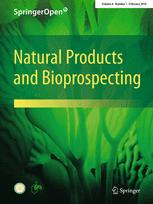|
|
Novel indole and quinoline alkaloids from Melodinus yunnanensis
Collect
Xiang-Hai CAI, Yan LI, Jia SU, Ya-Ping LIU, Xiao-Ning LI, Xiao-Dong LUO
Natural Products and Bioprospecting. 2011, 1 (1): 25-28.
DOI: 10.1007/s13659-011-0001-0
6/7-Seco rearranged spiro-indolone alkaloids, meloyunines A(1) and B(2) and a monoterpenoid quinoline alkaloid meloyunine C(3) together with its possible intermediate 14, 15-dehydromelohenine B(4), and their precursor Δ14-vincamenine(5) were isolated from Melodinus yunnanensis. All structures were elucidated based on NMR, FTIR, UV, and MS spectroscopic data. The isolation of monoterpenoid indole, quinoline, and its immediate from the same plant chemically supported the biosynthesis of quinoline from indole. Compound 2 was cytotoxic against several human cancer cell lines
References |
Related Articles |
Metrics
|
|
|
Three new nortriterpenoids from Schisandra wilsoniana and their anti-HIV-1 activities
Collect
Guang-Yu YANG, Yin-Ke LI, Xing-Jie ZHANG, Xiao-Nian LI, Liu-Meng YANG, Yi-Ming SHI, WeiLie XIAO, Yong-Tang ZHENG, Han-Dong SUN
Natural Products and Bioprospecting. 2011, 1 (1): 33-36.
DOI: 10.1007/s13659-011-0008-6
Three new highly oxygenated nortriterpenoids, wilsonianadilactones D-F(1-3), were isolated from the leaves and stems of Schisandra wilsoniana. Their structures were established by means of spectroscopic analysis. Compounds 1-3 showed weak anti-HIV-1 activity with the therapeutic index(TI) values(CC50/EC50) greater than 8.16, 14.7, and 17.5, respectively.
References |
Related Articles |
Metrics
|
|
|
Cyathane diterpenoids from fruiting bodies of Phellodon niger
Collect
Sheng-Tao FANG, Tao FENG, Ling ZHANG, Ze-Jun DONG, Zheng-Hui LI, Ji-Kai LIU
Natural Products and Bioprospecting. 2011, 1 (1): 37-40.
DOI: 10.1007/s13659-011-0002-z
Four new cyathane-type diterpenoids, nigernins C-F(1-4), together with four known compounds, were isolated from the fruiting bodies of the basidiomycete Phellodon niger. The structures of these new compounds were established on the basis of spectroscopic analysis, including 1D and 2D NMR experiments. In addition, nigernin F(4) with an unusual 3, 4-seco cyathane diterpenoid skeleton was found to occur in nature for the first time. It was suggested to be as an oxidation product of C-3-C-4 bond cleavage of nigernin E(3).
References |
Related Articles |
Metrics
|
|
|
Chemical constituents from the aerial parts of Musella lasiocarpa
Collect
Liao-Bin DONG, Juan HE, Xing-Yao LI, Xing-De WU, Xu DENG, Gang XU, Li-Yan PENG, Yu ZHAO, Yan LI, Xun GONG, Qin-Shi ZHAO
Natural Products and Bioprospecting. 2011, 1 (1): 41-47.
DOI: 10.1007/s13659-011-0007-7
Phytochemical investigation of the aerial parts of the monotypic plant, Musella lasiocarpa, led to the isolation of four rare bicyclic diarylheptanoids, musellarins B-E(2-5), two new phenylphenalenones, 2-methoxy-9-(3', 4'-dihydroxyphenyl)-1H-phenalen-1-one(9), 2-methoxy-9-(3'-methoxy-4'-hydroxyphenyl)-1H-phenalen-1-one(10), a new acenaphtylene derivative, trans-(1S, 2S)-3-(4'-methoxyphenyl)-acenaphthene-1, 2-diol(13), and two new sucrose esters, 1, 2', 3', 4', 6'-O-pentaacetyl-3-O-trans-p-coumaroylsucrose(16), 1, 2', 3', 4', 6'-O-pentaacetyl-3-O-cis-p-coumaroylsucrose(17), together with nine known compounds. In addition,(4E, 6E)-1-(3', 4'-dihydroxyphenyl)-7-(4"-hydroxyphenyl)-hepta-4, 6-dien-3-one(15) was isolated for the first time from a natural source. The structures of new compounds were elucidated by analysis of their spectroscopic data. Compounds 2, 6, 8-10, 12, and 14 were cytotoxic toward several of the human tumor cell lines(HL-60, SMMC-7721, A-549, MCF-7, and SW480). Of these, the new compound 9 was the most potent one, with IC50 values of 5.8, 10.3, 6.3, 3.3, and 2.3 μM, respectively.
References |
Related Articles |
Metrics
|
|
|
Anti-hepatitis B virus active secoiridoids from Swertia kouitchensis
Collect
Kang HE, Yun-Bao MA, Chang-An GENG, Xue-Mei ZHANG, Tuan-Wu CAO, Fu-Qiang JIANG, Ji-Jun CHEN
Natural Products and Bioprospecting. 2011, 1 (1): 48-51.
DOI: 10.1007/s13659-011-0009-5
Three new secoiridoids, swertiakoulactone(1) and swertiakosides A and B(2 and 3), were isolated from Swertia kouitchensis. Their structures were elucidated by comprehensive spectroscopic analyses including MS, IR, 1D and 2D NMR data. By the anti-hepatitis B virus(HBV) assay on Hep G 2.2.15 cells line in vitro, compound 1 showed moderate activities inhibiting the HBsAg secretion(IC50=1.10 mM, SI=4.39) and HBV DNA replication(IC50=1.16 mM, SI=4.12).
References |
Related Articles |
Metrics
|
|
|
Cyclopeptides from Amanita exitialis
Collect
Jing-Hua XUE, Ping WU, Yu-Lang CHI, Liang-Xiong XU, Xiao-Yi WEI
Natural Products and Bioprospecting. 2011, 1 (1): 52-56.
DOI: 10.1007/s13659-011-0013-9
A new cyclic nonapeptide, amanexitide(1), along with the known cyclopeptides, α-and β-amanitins, was isolated from the fruiting bodies of Amanita exitialis, a newly described poisonous mushroom endemic to Guangzhou, Guangdong Province, China. Its amino acid composition and absolute configuration were determined by chemical degradation and derivatization followed by chiral GC analysis. Its amino acid sequence was elucidated by extensive analysis of ESIMS/MS and FTICRMS data. The occurrence of 1 in this mushroom is interesting because it has a structure closely related to antamanide, a cyclic decapeptide with antidote activity against amatoxins and phallotoxins, occurring in A. phalloides.
References |
Related Articles |
Metrics
|
|

